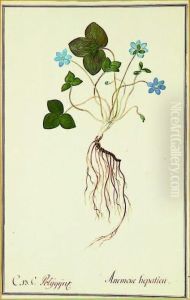Nikolaus Joseph Jacquin Paintings
Nikolaus Joseph Jacquin, born on February 16, 1727, in Leiden, Netherlands, was a distinguished figure in the fields of botany, chemistry, and zoology, though not primarily known as an artist in the traditional sense. His contributions to the natural sciences during the 18th and early 19th centuries were significant, and his work had a lasting impact on how plants and natural specimens were classified and understood. Jacquin's journey into the sciences was marked by his education and explorations, which led him to become a key figure in European scientific circles.
After studying medicine and chemistry in Leiden, Jacquin was sponsored by the Holy Roman Emperor Francis I to undertake a scientific expedition to the West Indies and South America between 1755 and 1759. This expedition allowed him to collect plants, animals, and minerals across the Caribbean, Venezuela, Colombia, and Panama. Upon his return to Europe, Jacquin's findings contributed immensely to the botanical gardens of Schönbrunn Palace in Vienna and the University of Vienna, where he later served as a professor.
Jacquin's work in cataloging and classifying his findings led to the publication of several important works, including 'Enumeratio Systematica Plantarum', 'Selectarum Stirpium Americanarum Historia', and 'Icones Plantarum Rariorum'. His contributions to botany were not only in plant classification but also in the illustration of plants, making his work significant for both scientific and artistic reasons. His illustrations were noted for their accuracy and beauty, serving as a bridge between art and science.
Throughout his career, Jacquin was honored with memberships in various scientific societies and received numerous accolades for his work. His legacy is preserved in the botanical nomenclature, with several plants named in his honor, such as the genus Jacquinia. Nikolaus Joseph Jacquin's death on October 26, 1817, marked the end of an era in the natural sciences, but his contributions continue to be revered in both the scientific and artistic communities.
